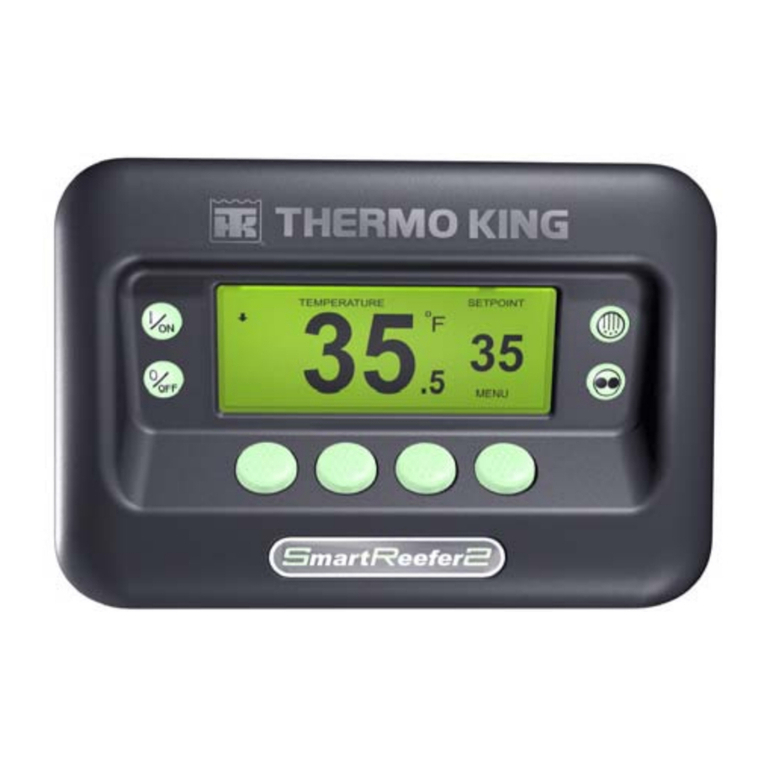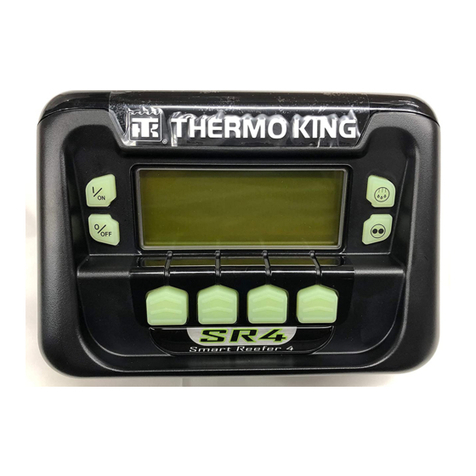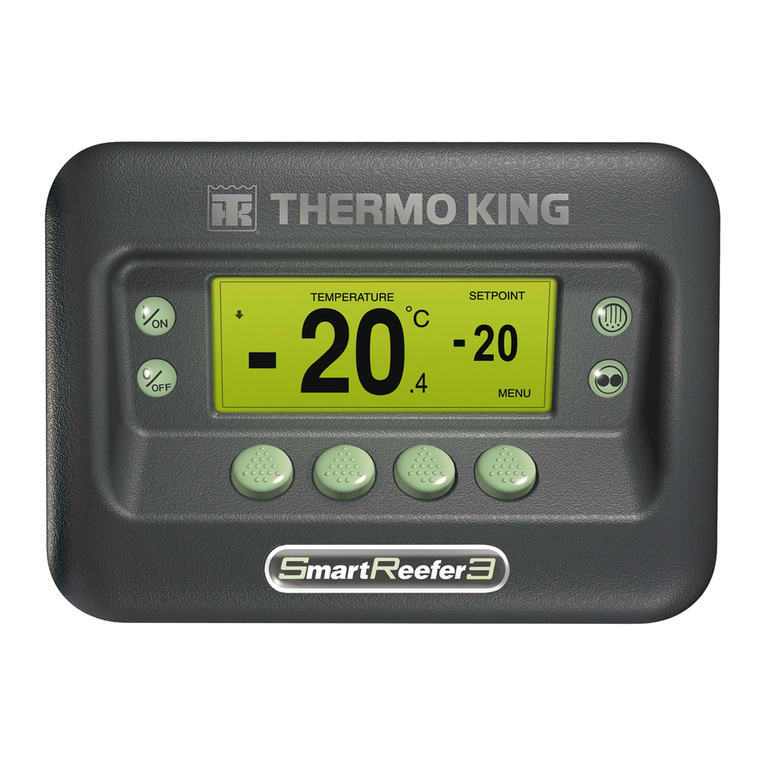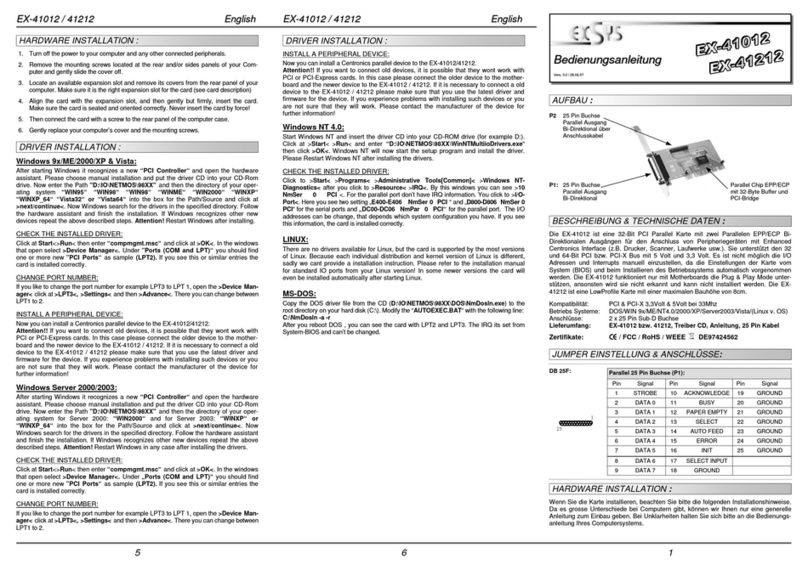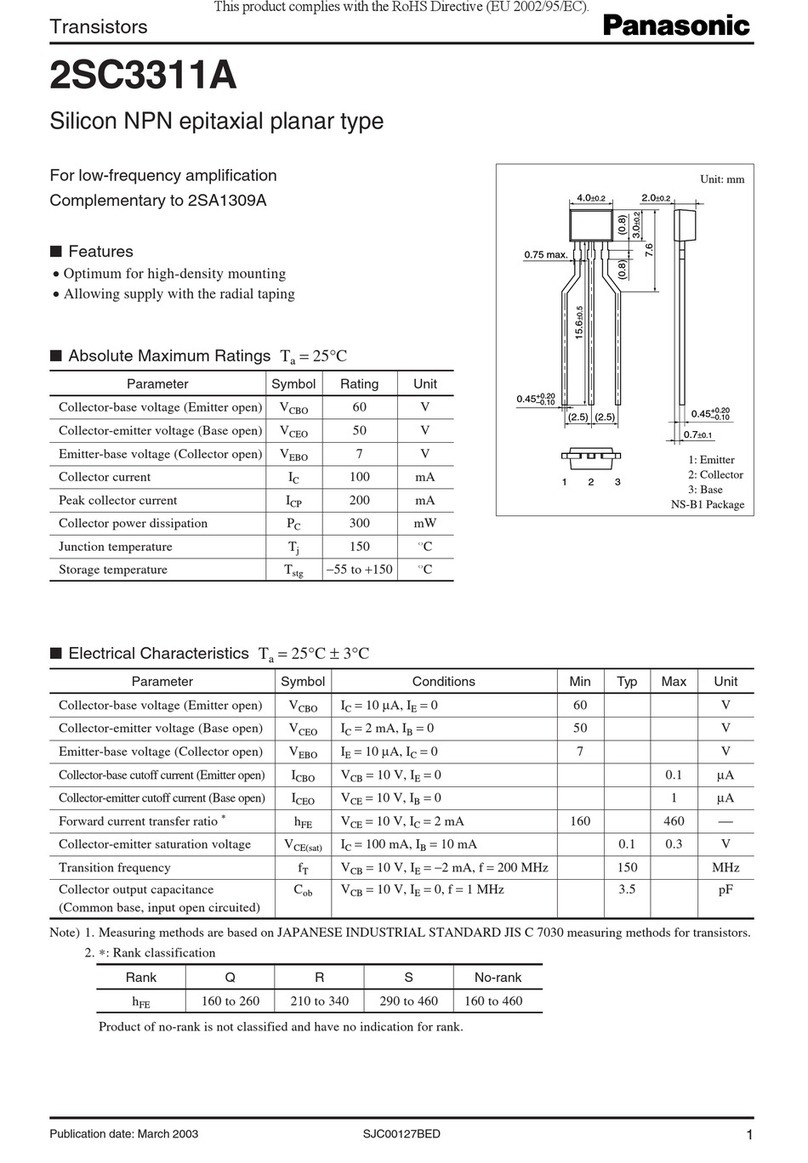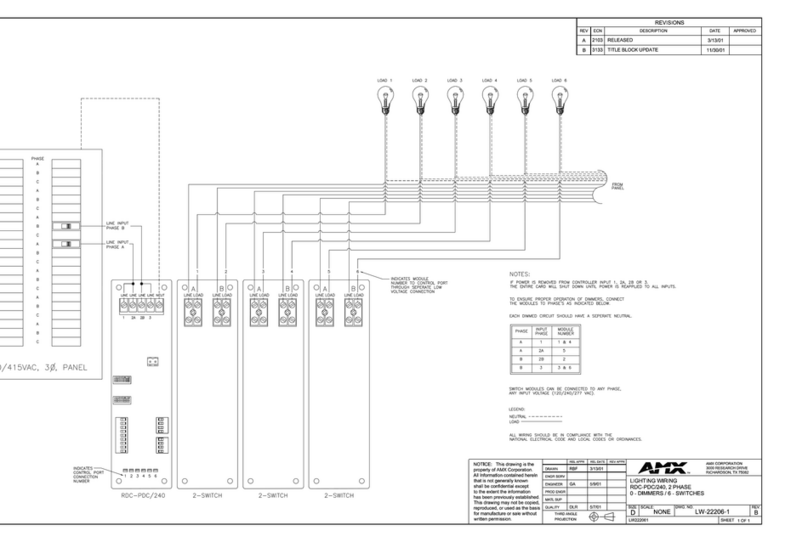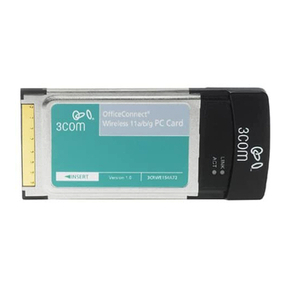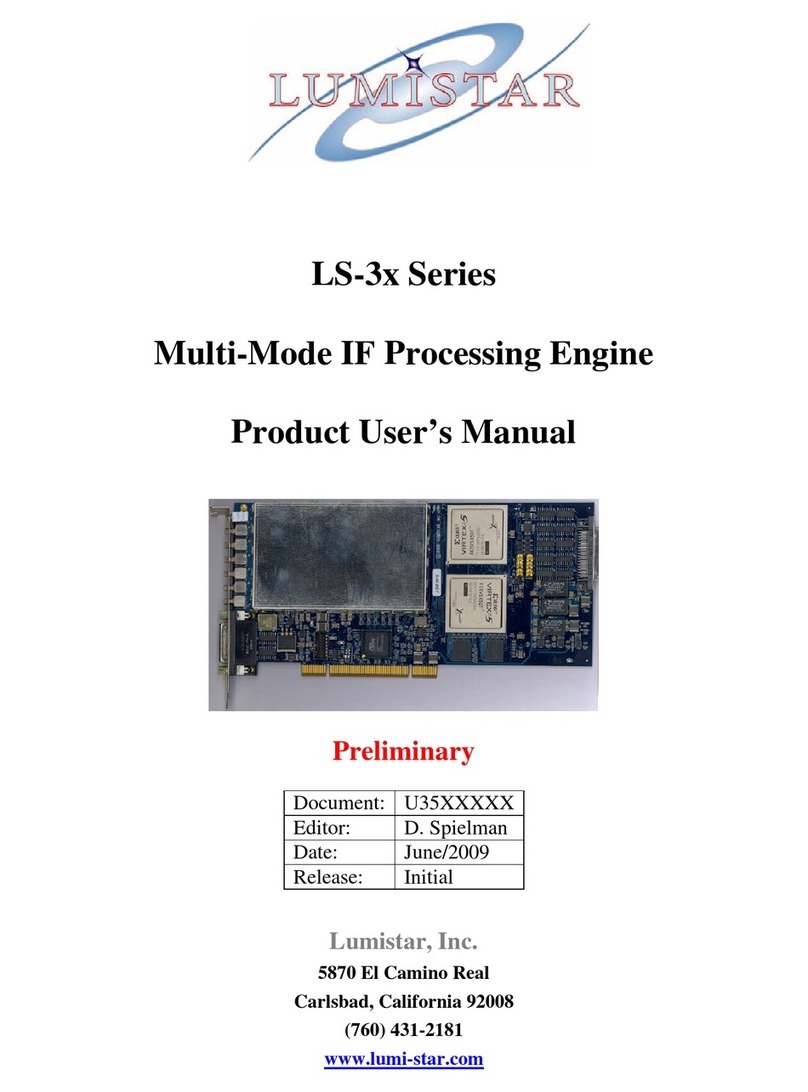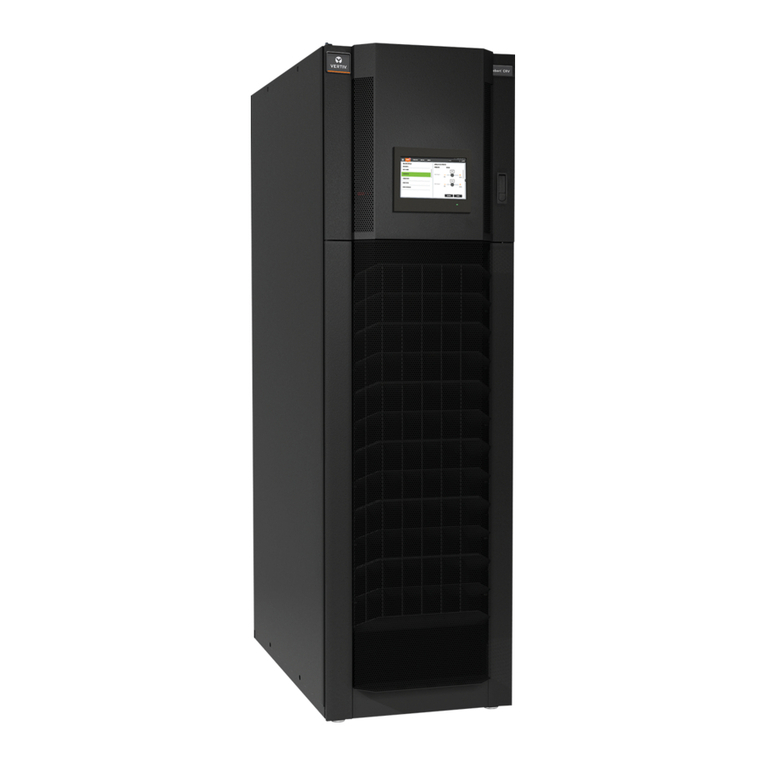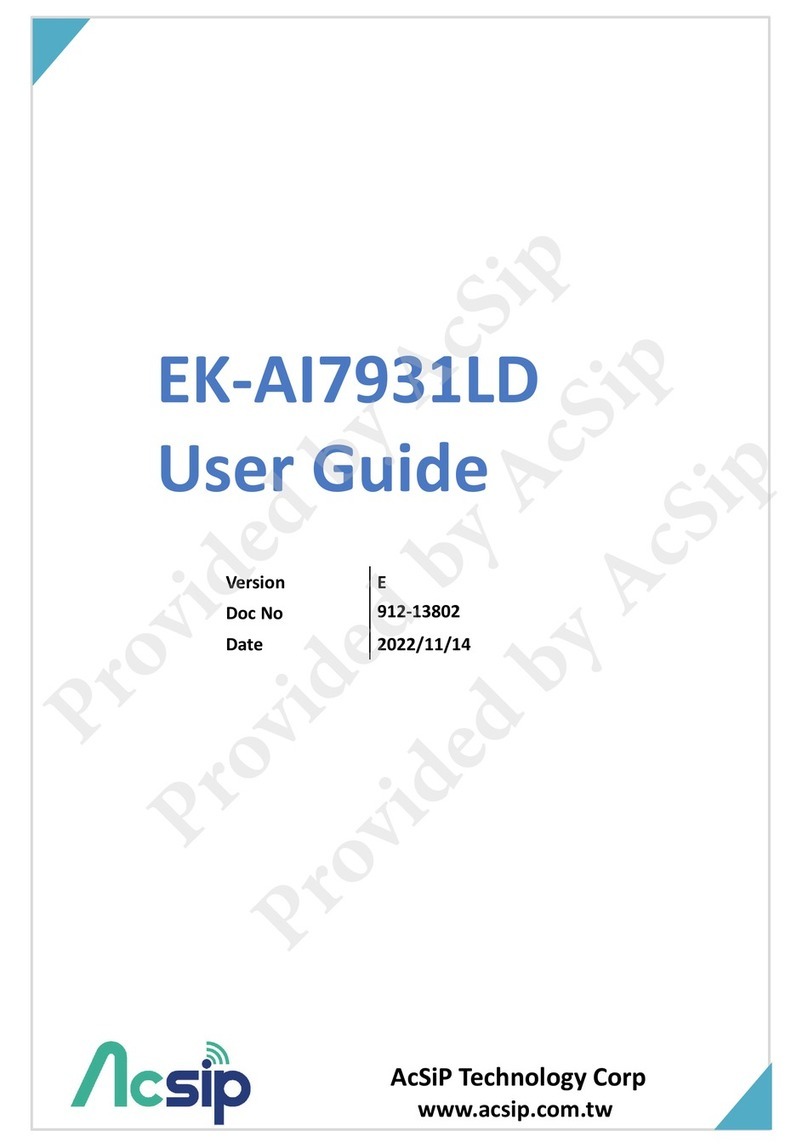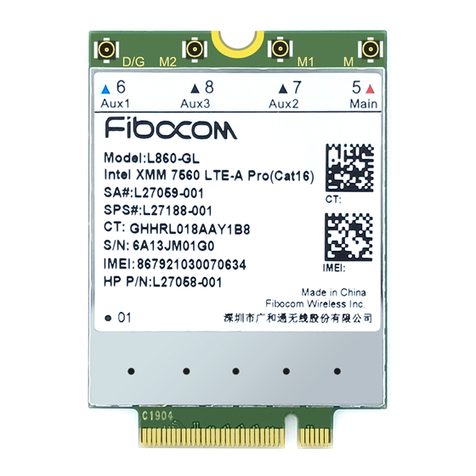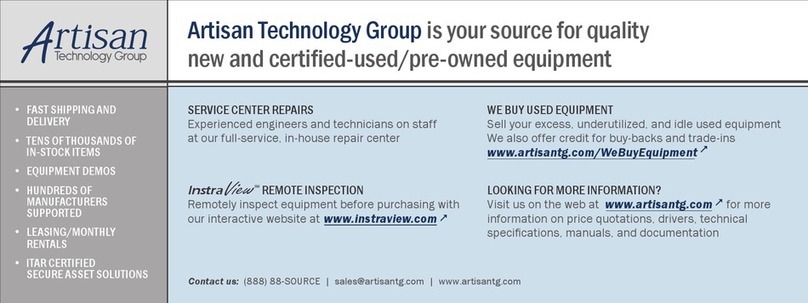Thermo King Smart Reefer 2 Installation and operation manual

Simple to Start:
1. Press the ON Key.
2. A series of start-up screens will
appear.
3. The Standard Display appears
showing setpoint and box
temperature when the unit is
running.
4. The Standard Display defaults to the “Temperature Watch” screen after
2 1/2 minutes. This screen displays same setpoint and box temperature in
larger font.
NOTE: For more detailed information, see the Operation chapter in
the appropriate unit operating manual.
Simple to Set:
CYCLE-SENTRY or Continuous Run
1. Return to the Standard
Display.
2. Press the MODE
SELECTION Key.
3. The “Programming
Continuous Mode” or
“Programming CYCLE-
SENTRY Mode” screen briefly
appears.
4. The “New System Mode is
Continuous” screen or the
“New System Mode CYCLE-
SENTRY” screen briefly
appears.
5. The Standard Display appears and the heading on top of screen reads
the new mode.
6. Pressing the MODE SELECTION Key again will change the unit back to
the previous mode.
NOTE: For more detailed information, see the Operation chapter in
the appropriate unit operating manual.
3
1
4
1
2 & 6
5
5
Simple to Set:
Setpoint Temperature
1. Return to the Standard
Display.
2. Press the SETPOINT Key
on the Standard Display.
3. Press the + or - Keys to
change the setpoint reading.
4. Press the YES or NO key
accordingly.
5. The Standard Display
appears with setpoint changed
to the new setpoint.
NOTE: For more detailed
information, see the
Operation chapter in the
appropriate unit operating
manual.
Simple to Check:
Gauges
1. Return to the Standard
Display.
2. Press the GAUGES Key.
3. Press BACK or NEXT
Keys to scroll through
following gauges: Coolant
Temperature, CoolantLevel,
Engine Oil, Pressure, Amps, Battery Voltage, Engine RPM, Discharge
Pressure, Suction Pressure, ETV Position, I/O. If no keys are pressed
within 30 seconds, the screen will return to the Standard Display.
4. Press the LOCK Key to display any gauge screen for an indefinite
period. Press the key again to unlock the screen.
5. Press the EXIT Key to return to the Standard Display.
NOTE: For more detailed information, see the Operation chapter in
the appropriate unit operating manual.
2
1
4
3
5
1
2
5 4 3 3
Simple to Defrost:
Initiate Manual Defrost
1. Return to the Standard
Display.
2. Press the DEFROST Key.
3. Miscellaneous defrost
programming screens appear.
4. A modified Standard Display
screen appears. The bar
indicator will fill in showing the
timeremainingto completethe
Defrost cycle. When the
Defrost cycle is complete the
display returns to Standard
Display screen.
NOTE: For more detailed information, see the Operation chapter in
the appropriate unit operating manual.
Simple to Access:
Sensors
1. Return to the Standard
Display.
2. Press the SENSORS Key.
3. Press the BACK or NEXT
Keys to scroll through the
following sensor screens:
Control Return Air
Temperature, DisplayReturn
Air Temperature, Control Discharge Air Temperature, Display Discharge
Air Temperature, Temperature Differential, Evaporator Coil Temperature,
Ambient Air Temperature, Spare 1 Temperature, Datalogger Temperature
Sensors 1-6 and the Board Temperature Sensor. If no keys are pressed
within 30 seconds, the screen will return to the Standard Display.
4. Press the LOCK Key to display any sensor screen for an indefinite
period. Press the key again to unlock the screen.
5. Press the EXIT Key to return to the Standard Display.
NOTE: For more detailed information, see the Operation chapter in
the appropriate unit operating manual.
2
1
34
2
1
5 4 3 3
Simple to Check:
Pretrip Test
1. Clear all alarm codes.
2. Return to the Standard
Display.
3. Press the MENU key.
4. Press the NEXT Key as
required to show the Pretrip
Menu.
5. Press the SELECT Key to
start a Pretrip Test.
6. If the unit is not running, a Full
Pretrip will be initiated. If the unit
is running in either diesel or
electric mode, a Running Pretrip
will be performed.
7. When all tests are complete, the resultsare reported as PASS, CHECK or
FAIL. If the results are CHECK or FAIL, the accompanying alarm codes will
direct the technician to the cause of the problem.
NOTE: For more detailed information, see the Operation chapter in the
appropriate unit operating manual.
Simple to Check:
Hourmeters
1. Return to the Standard Display
screen.
2. Press the MENU Key.
3. Scroll through Main Menu by
repeatedly pressing the NEXT and
BACK Keys until the hourmeters
Main Menu Screen appears.
4. Press the SELECTKeyto enter the Hourmeters Menu.
5. Press the NEXT and BACK Keys to view the Hourmeter Displays.
NOTE: For more detailed information, see the Operation chapter in the
appropriate unit operating manual.
3
2
54
7
2
1
43 & 5 3 & 5

Simple to View:
Cause of Alarm
1. Return to the Standard
Display Screen.
2. Press the MENU Key.
3. Press the NEXT Key until
the Alarm Menu appears.
4. Press the SELECT Key.
The Alarm Display will appear
5. If no alarms are present,
Alarm 00 is shown.
6. Press the EXIT Key to return
to the Standard Display.
7. If alarms are present, the
quantity of alarms and the
most recent alarm code
number will be shown.
8. If there is more than one
alarm, press the NEXT Key to
view each alarm.
9. If a serious alarm occurs,
the unit will be shut down to prevent damage to the unit or the load. If this
occurs, the display will show that the unit is shut down and display the
alarm code that caused the shutdown.
NOTE: For more detailed information, see the Operation chapter in the
appropriate unit operating manual.
Simple to View:
Clearing Alarm Codes
1.Press the CLEAR Key to
clear an alarm.
2. The display screen will
return to the Standard Display
when the alarms are cleared.
3. Press the HELP key for
additional information
regarding the alarm shown on
the display. Also see the
complete Alarm Code list in the
next column.
NOTE: For more detailed
information, see the
Operation chapter in the
appropriate unit operating
manual.
2
1
7
43
65
1 3 2
Simple to Determine:
Cause of Alarm
0. No Alarms Exist
2. Evaporator Coil Sensor
3. Control Return Air Sensor
4. Control Discharge Air Sensor
5. Ambient Air Sensor
6. Coolant Temperature Sensor
7. Engine RPM Sensor
9. High Evaporator Temperature
10. High Discharge Pressure
11. Unit Controlling on Alternate Sensor
12. Sensor Shutdown
13. Sensor Check
15. Glow Plug Check/Intake Air Heater
17. Engine Failed to Crank
18. High Engine Coolant Temperature
19. Low Engine Oil Pressure
20. Engine Failed to Start
21. Cooling Cycle Check
22. Heating Cycle Check
23. Cooling Cycle Fault
24. Heating Cycle Fault
25. Alternator Check
26. Refrigeration Capacity Check
27. Motor RPM High
28. Pre-Trip Abort
29. Defrost Damper Circuit
30. Defrost Damper Stuck Closed
31. Oil Pressure Switch
32. Refrigeration Capacity Low
33. Check Engine RPM
35. Run Relay Circuit
36. Electric Motor Failed to Run
37. Engine Coolant Level
38. Electric Phase Reversed
39. Water Valve Circuit
40. High Speed Circuit
41. Check Engine Coolant Temperature
42. Unit Forced to Low Speed
43. Unit Forced to Low Speed Modulation
44. Check Fuel System
45. Hot Gas Bypass or Hot Gas Bypass Circuit
46. Check Air Flow
48. Check Belts or Clutch
50. Reset Clock
52. Heat Circuit
53. Economizer Valve Circuit
54. Test Mode Time-Out
55. Check Engine Speeds
61. Low Battery Voltage Check
62. Ammeter Out of Calibration Range
63. Engine Stopped - Reason Unknown
64. Pretrip Reminder
66. Low Engine Oil Level
67. Liquid Line Solenoid
70. Hourmeters Failure
71. Maintenance Hourmeter 4 Exceeds Set Time Limit
72. Maintenance Hourmeter 5 Exceeds Set Time Limit
73. Maintenance Hourmeter 6 Exceeds Set Time Limit
74. Controller Reset to Defaults
75. Internal Fault Codes
76. Internal Fault Codes
77. Internal Fault Codes
78. Internal Fault Codes
79. Data Log Overflow
80. Compressor Temperature Sensor
81. High Compressor Temperature
82. High Compressor Temperature Shutdown
83. Low Coolant Temperature
84. Restart Null
85. Forced Unit Operation
86. Discharge Pressure Sensor
87. Suction Pressure Transducer
89. Electronic Throttling Valve Circuit
90. Electric Overload
91. Electric Ready Input
92. Sensor Grades Not Set
93. Low Compressor Suction
94. Loader #1
95. Loader #2
96. Low Fuel Level
98. Fuel Level Sensor
99. High Compressor Pressure Ratio
108.Door Open Time-Out
109.High Discharge Pressure
111. Unit Configuration
117.Auto Switch to Electric
118.Auto Switch to Diesel
121.Liquid Injection Circuit
122.Diesel/Electric Relay Circuit
127.Setpoint Not Entered
128.Engine Run Time Maintenance Reminder #1
129.Engine Run Time Maintenance Reminder #2
130.Electric Run Time Maintenance Reminder #1
131.Electric Run Time Maintenance Reminder #2
132.Total Unit Run Time Maintenance Reminder #1
133.Total Unit Run Time Maintenance Reminder #2
134.Power On Hours
135.Spare DIgital Inputs
136.Spare Digital Outputs
203.Display Return Air Sensor
204.Display Discharge Air Sensor
SR-2
Smart Reefer 2
Microprocessor
Driver Guide to
Simple
Operation
TK 51588-2-PC (Rev. 1, 12/03) ©Thermo King Corporation
Other manuals for Smart Reefer 2
2
This manual suits for next models
1
Other Thermo King Computer Hardware manuals
Popular Computer Hardware manuals by other brands
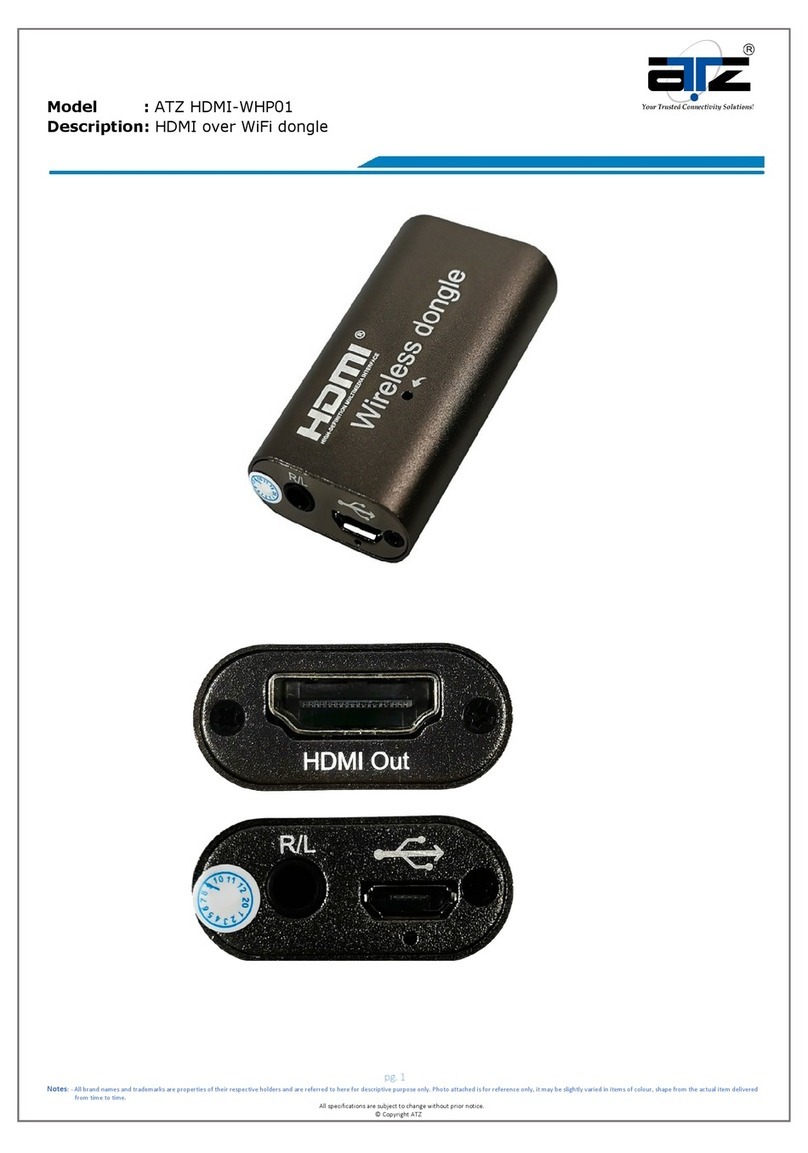
ATZ
ATZ HDMI-WHP01 manual
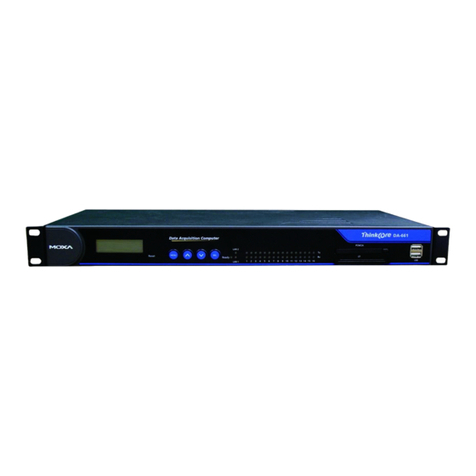
Moxa Technologies
Moxa Technologies DA-661 Quick installation guide
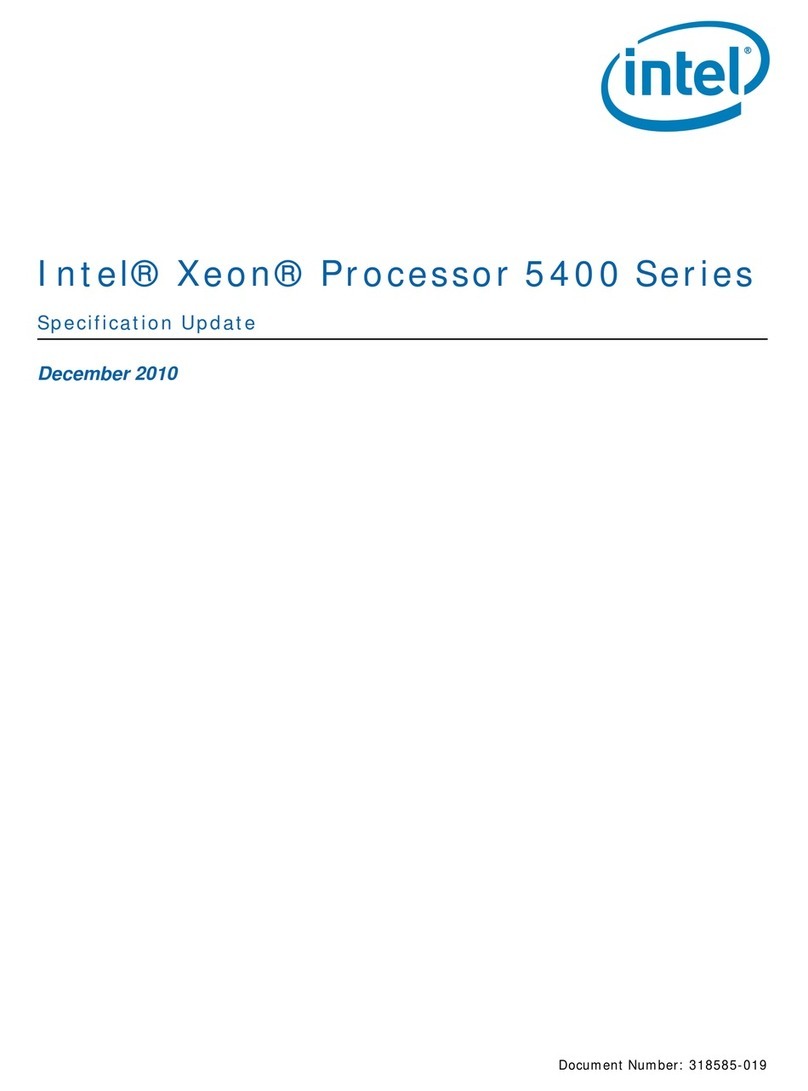
Intel
Intel E5420 - CPU XEON QUAD CORE 2.50GHZ FSB1333MHZ 12M LGA771 HALOGEN FREE... specification
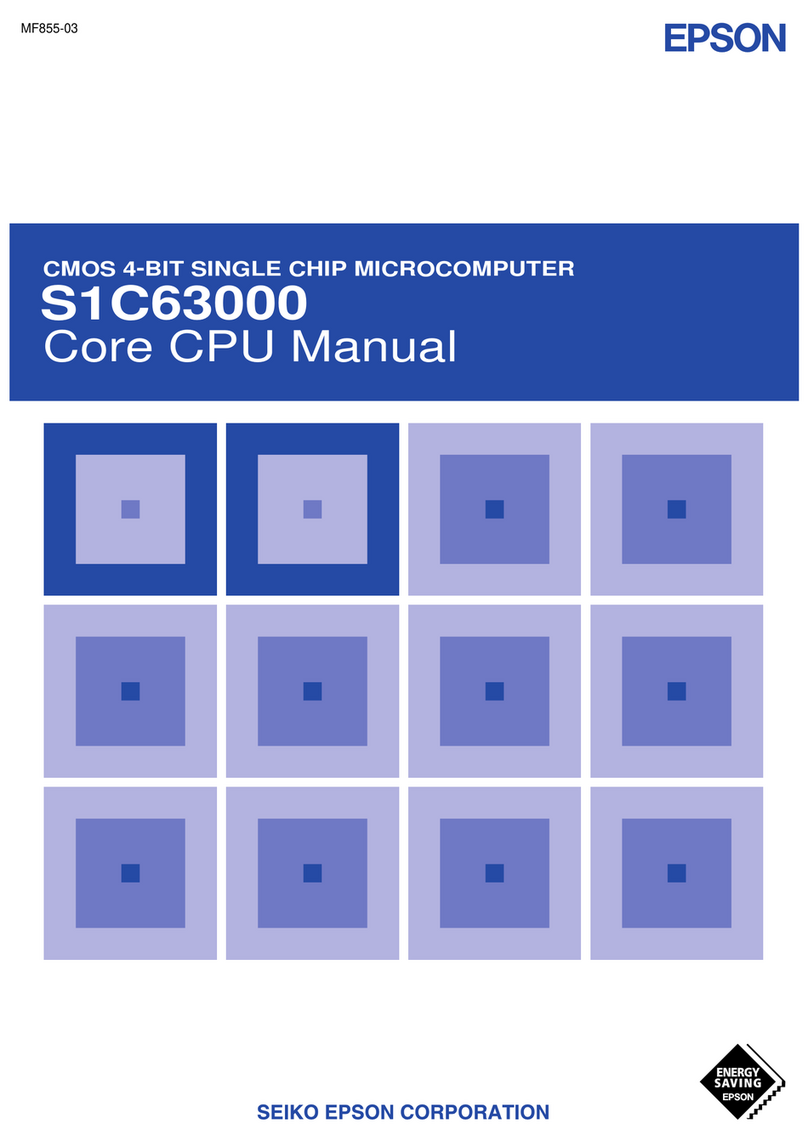
Epson
Epson S1C63000 Core cpu manual
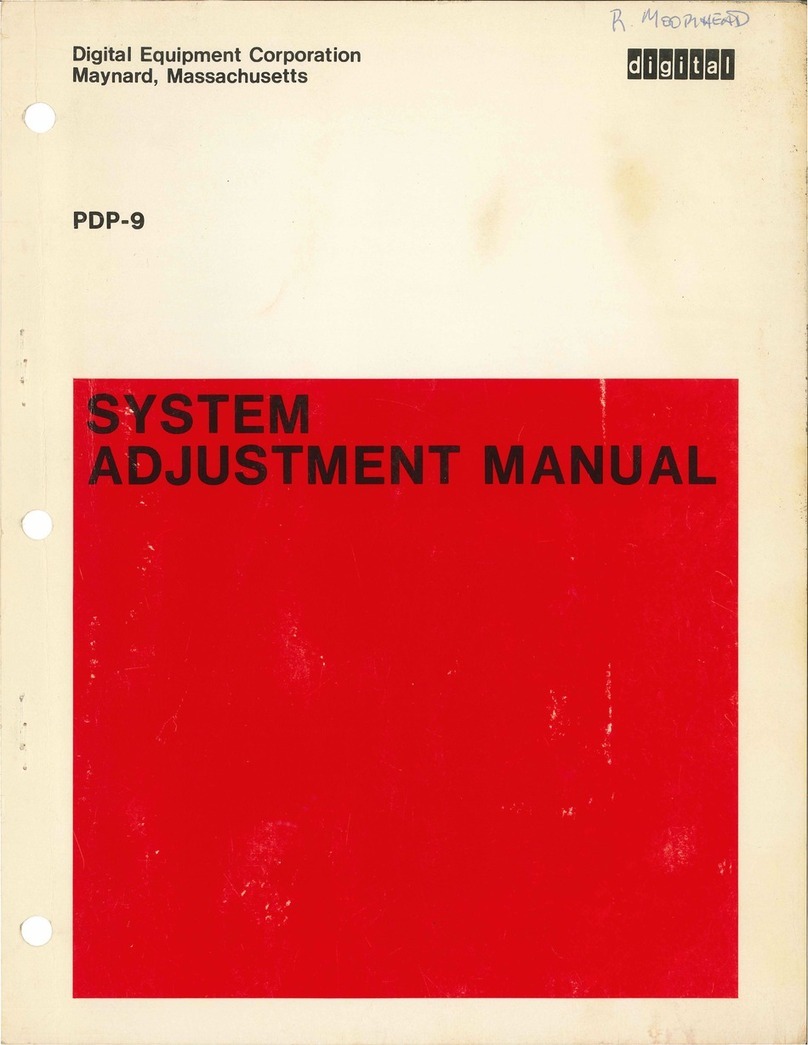
Digital Equipment
Digital Equipment PDP-9 Adjustment manual
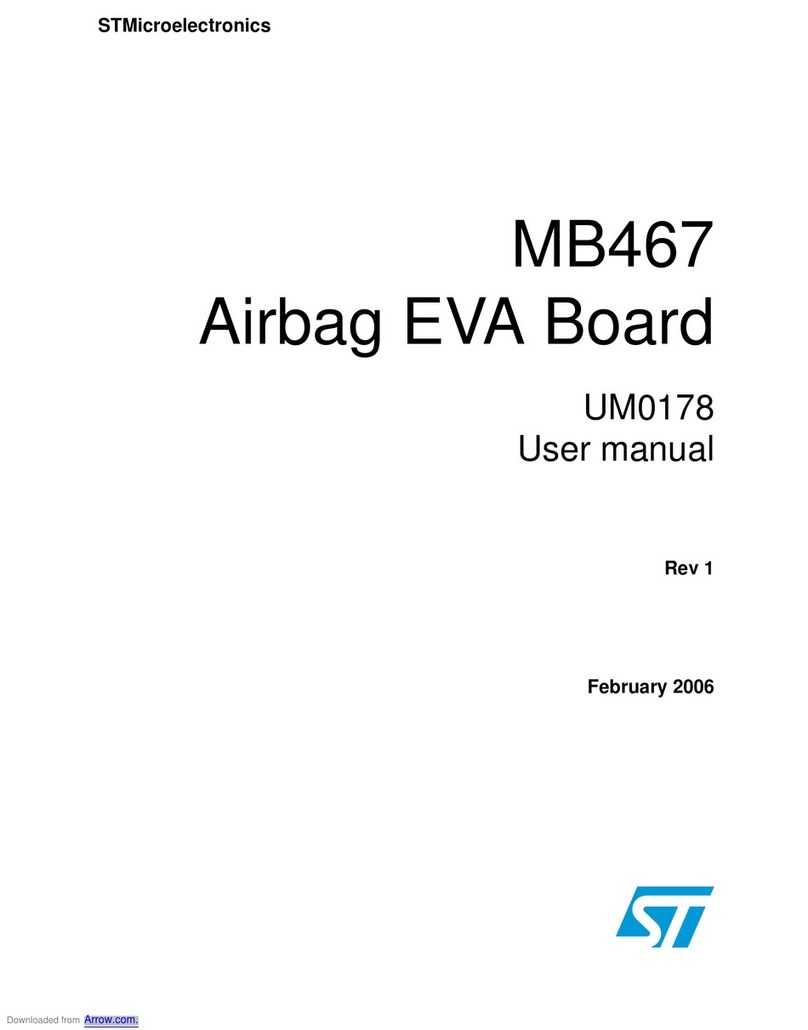
ST
ST MB467 user manual

